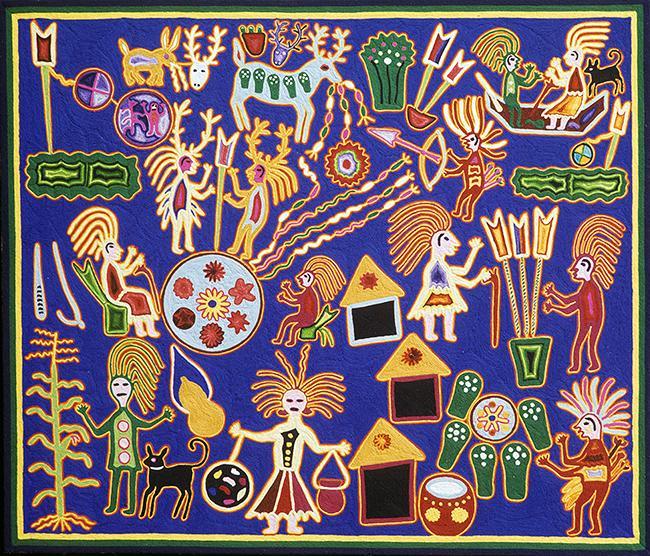The Founding of the World: After the Flood

Our Ancestors found the first dry land after the flood at Xapaviyemetá. In the canoe (upper right) sit Watákame with his paddle, Takutsi, Our Great Grandmother, with her staff (itsú), and the black bitch of Watákame, embodying Tatéi Yurianaka, Our Mother Moist Earth, with the squash, maize and grains they saved. They consecrate this spot by leaving (on the variegated green area) an arrow and a nierika. Watákame placed his arrow in Hauramanaka, in the present state of Durango and attached to it (top left) a votive bowl, xukuri, to Tatéi Yurianaka and his nierika, with the design of the Clearer of the Fields and a corn stalk.
Takutsi begins her search for the Nierika Mamma, which bears the symbols of the sixth ancestor, Watákame. It is found near where it had been left, at Kiewimuta. Gathered again before the nierika are Takutsi (at left) with her staff and Tatewarí, Our Grandfather Fire, seated on their sacred chair, uwene, while Tamatsi Kauyumari, Our Elder Brother Fawn of the Sun, and Tatutsí Maxakuaxí, Our Great Grandfather Deer Tail, appear above, flanking a large arrow. Takutsi orders them to take this arrow to Wírikuta, which lies to the east, though she makes their way difficult by trying to confuse them with messages sent through the nierika (as wavy lines).
As they near the sacred water sources of the east at Tatéi Matinieri, the antlers of the two deer-people fall from their heads. Tatutsí Maxakuaxí eats his antlers, though they are also his muvierixi, the plumed feathers that transmit messages to our ancestors, and for his mistakes he is transformed into the rabbit, tatsiu (top left). Tamatsi Kauyumari takes his antlers with him and is finally able to reach the center of Wírikuta. Seeking his spiritual being, he takes his bow and arrow (at right below the canoe) to hunt the peyote, hikuri, in which he is also embodied as a deer. Takutsi telepathically attempts to stop him but his nierika (seen attached to the deer's mouth) deflects her messages, and he shoots his arrow into the peyote. When Our Great Grandfather Deer Tail finally reaches Wírikuta in rabbit form he is unable to achieve the same transformation and becomes instead a large cactus some confuse with peyote called maxakuaxí (right of the deer Kauyumari). They each leave their arrow here at Takau, the blue arrow of Tamatsi Kauyumari and the red of Tatutsí Maxakuaxí. Kauyumari then makes ready for his return. He prepares an aikutsi, a votive bowl filled with peyote (seen atop his back). He leaves his antlers behind and, with his arrows and bowl, he departs Wírikuta.
Takutsi and Tatewarí have remained guarding Nierika Mamma until the return of the two deer-people. When Tamatsi Kauyumari arrives, the four ancestors who stayed behind accept the peyote that is being offered. Takutsi, once having eaten hers, decides to find a more appropriate spot for the sacred nierika. A copy is made and it is carried to Teakata, where Nierika Mamma is now seen surrounded by peyote (lower right). It is here that Takutsi, Tatewarí and Tamatsi Kauyumari (clockwise at lower right) founded their shrines and placed their sacred arrows. From the bowl beside the lower shrine is served ground peyote as the ancestors celebrate the feast of hicuri. When the feast ends, Tamatsi Kauyumari returns to Wírikuta where Maxakuaxí stayed.
Tatéi Yurianaka (bottom center) has, in the meantime, decided to return to the coast, accompanied by Watákame and her alter ego the black bitch. She carries with her a pot and a votive gourd containing all the seeds for new growth. Watákame carries his water gourd, his cutting tool and his turikui, a stick used to gather the brush he chopped. The maize plant symbolizes the fertile growth since found near the coast. Reaching the coast, Tatéi Yurianaka goes on to enter the ocean and becomes Tatéi Waxiewe, the sacred rock off the coast of what is now San Blas.
Explanation and Translation by Juan Negrín based on a tape recorded conversation with the artist. Copyright ©Juan Negrin 1973 – 2018 All rights reserved digital and print.
Photograph ©Lloyd Patrick Baker





